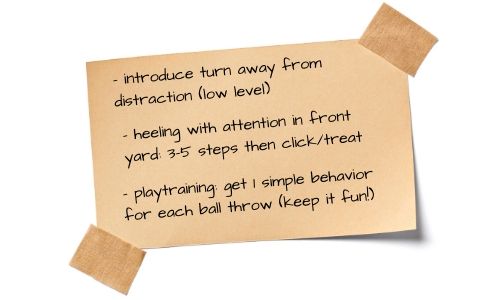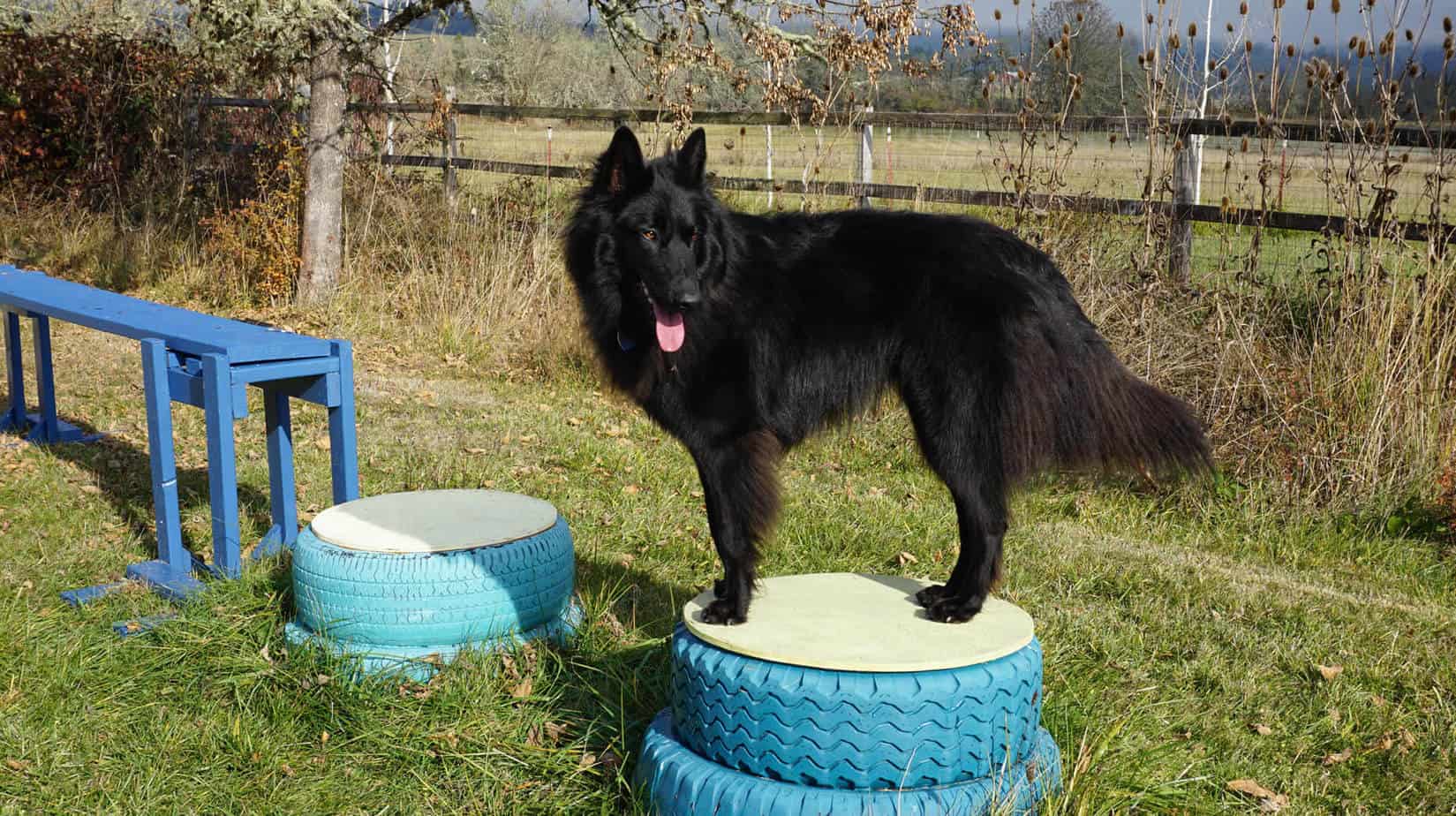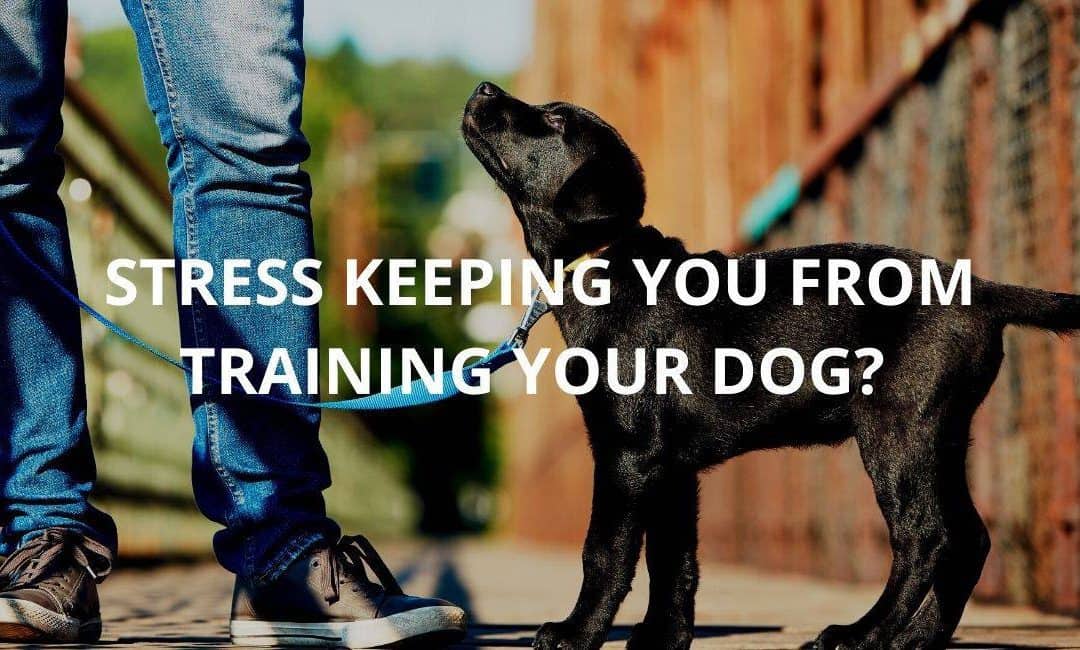As dog owners, we all know the importance of training our dogs regularly and consistently. It builds trust and strengthens our relationship. And they need the structure, training, and mental stimulation.
But what if you’re too stressed and overwhelmed? Maybe training feels too much like one more thing to deal with?Â
If so, I thought you might get some use out of a habit I developed a few years ago. It’s very simple, but for me anyway, helps me actually accomplish what I need to get done with my dogs. (Although it would work with most any goal.)Â
Some background: in addition to living with three high energy, highly intelligent dogs who expect to be worked with regularly, I manage the day-to-day household needs for myself and my husband (okay – and my dogs), and own my own small business. One consequence of this is that I am, on any given day, prone to feeling overwhelmed with everything that needs to be done.
I’m one of those people whose instincts are to veer away from stress. But also someone who loves to see what I can accomplish.
Which means I’ve had to develop strategies for getting things done in the face of instinctive stress avoidance.

What I was finding, as life got busier, was that when I had a few spare minutes to train my dog, the very thought of “okay, what shall we work on?†would send me scurrying back into my corner. When you’re nudging elbows with overwhelm, that’s what can happen when you try to insert decision-making. (Sounding familiar at all?)
And the one simple thing that helped? Once a week, I started making a list. (Told you it was simple.)
Most every Sunday, I write down a short list of things I’d like to work on with my dogs in the upcoming week.
Then, in one of those in-between moments, before I start a new tasks or am just ready for a quick change of pace, I check my list and pick one thing that appeals to me at that moment.
This is about as close to stress-free decision-making as you’re going to to get.
Picking from a short list of realistic training goals is about as close to stress-free decision making as you’re going to get.Â

A quick hand-written note works just fine for a training to-do list. Make a new list weekly, and keep it short and sweet.
Tips for Making a Dog Training To-Do List
Think of things you’ll be able to look back on and be pleased you accomplished.
Maybe for you, that’s teaching your dog a selection of new tricks. Or maybe it’s improving self-control. Maybe getting that sit-stay a little more solid in the face of distractions. Maybe more polite, attentive leash walking!
However you do it, make it yours.
Keep It Short & Sweet
To work, the list needs to be short. You want choice, but not so much choice that you waste time trying to decide between options. Four to six items works well for me. Remember, the idea is to be able to “grab and goâ€, not deliberate over which option is best.
And just to say, there’s no pressure for the list to be some brilliant, linear, well thought-out plan. In fact, I tend to accomplish at least as much by working on seemingly random bits and pieces.
Maybe it’s just my dogs, but they are very good at stitching the pieces together over time. (Seriously, they amaze me sometimes how they can do this.)
As the weeks go by, however, you might want to look back at your lists. Are there areas you’ve focused too much or too little on? No? Then keep on keepin’ on. Yes, maybe, just a bit? Then adjust, adapt and move forward!
Give Yourself Some Choice
With my dogs, I’m usually working on several things at any one time. This is not because I’m insanely ambitious, but because I get bored easily and don’t always feel like working on the same thing. So my list usually includes about half a dozen behaviors.
This gives me a nice variety to choose from, depending on my mood, how much time I have, the weather, etc.
Most weeks I don’t get to all that I picked; often more like three or four. And that’s fine.
Accomplishing a certain number of things is not one of my goals (although it could be one of yours).
Vary the Type of Goal
For your dog’s sake, and for yours, I recommend including a variety of types of behaviors to train, too. I prefer to be able to choose something that appeals to me in that moment when I have the time, energy, or motivation.
I think many dogs do better, too, when they get some variety in their lessons, rather than continual repetition of the same concepts. (Think of it as cross-training.)Â I tend to try for a selection of:
- Physical behaviors. These involve movement and can include jumping, hopping, holding/carrying, climbing, touching, turning/spinning, balancing, pawing, etc.
- Fun behaviors. These are great for showing off your training skills (and brilliant dog), but don’t necessarily have a ton of practical value. My nearly 11 year old Belgian Sheepdog girl, Tanis, does this thing I call “levitateâ€, where she stands on her hind legs completely upright. This is an impressive – but totally useless – behavior that she and I both enjoy. Now we’re working on her being able to turn in place while levitating. Why? Because it’s fun!
- Functional behaviors. These are either useful by themselves, necessary for your chosen dog sport, or help the dog gain important life skills like self-control, confidence, etc. If you’re unsure, you can’t go wrong with working on the basics of obedience training: sit, lie down, stand, come, leave it, wait and stay. If your dog has some gaps in his skill set, work on filling those in. If your dog has a particular skill down pat, practice using it in ways that are useful and make sense in your living situation.

Break it Down into Simple Pieces
Stress makes us less patient, more prone to taking disappointment to heart, less optimistic.
So be sure you choose something you feel confident about achieving.
What you work on should be challenging enough to be interesting and to allow for a sense of accomplishment. But avoid skipping steps, and making things so complicated that your dog struggles to understand what he’s supposed to do. That’s not motivating for either of you!
Commit to 100% Attention
When you decide to train, commit to being there 100%. That, in itself, may sound overwhelming!
But surely you can commit to 2 or 3 minutes of complete attention? If not, how about 45 seconds? Whatever you feel you can do, do it.
Then over time build that “focus muscleâ€. In these days of fragmented attention spans, that’s a valuable skill for all of us.
Plan for Some Cheats, Shortcuts and Inspiration
Cheats. I know that some days I may not feel much like training at all. On those days, I might brush my dog, or trim her nails, or even just work on getting 2 seconds of the Dremel on each nail.
We might play a game of Find It or Hide & Seek. Maybe we’ll play tug and fetch, but asking for a trick or obedience behavior before each grab or throw.
Shortcuts. Because I have multiple dogs, sometimes it’s fun and different to do some group training as a shortcut, instead of individual. I’ll grab some treats, and we’ll work on all three at once sitting, lying down, and standing on cue.
We’ll do group “waves†(paw raised high), spins, and group backing across the room. Having all three take a bow simultaneously is cute and fun.
Inspiration. Sometimes, if I’m feeling inspired (and ambitious), I’ll put two dogs on sit stays and heel the third dog around them. Then switch off dogs and repeat.
I would never do group training exclusively, since each dog needs and deserves individual training and personal time. But it’s a terrific way to get those brains and bodies exercised in a short period of time, and it does address an important training aspect of living with multiple dogs.
Another way to group train I’ve been working on lately is to work with one dog on leash, with a second dog free in the room with us. I generally don’t work that way, since I prefer to have the dog I’m training being able to concentrate on without interference (easier for them and me). But the second dog is a great distraction to work through if you’re working on familiar, well-practiced behaviors.
As a matter of fact, as I was writing this, I decided to add some interest, variety, and difficulty to the above exercise. Working with two dogs at a time, I tried it out in the front yard instead of inside. (For some reason, I only ever work with one dog at a time in the front yard.) There was some energetic excitement at first, but they settled into it and did great.
Then I brought out all three dogs, had two sit-stay at a time, while I heeled around them with the third dog. This got a bit challenging when the power company truck pulled up in the street, but we worked through it!
Wrapping Up
The options for what to work on with your dog are vast. The variety of choices can be exciting and inspiring, but also intimidating when it comes to making a decision on what to train, especially during times of stress.
Picking a small number of behaviors to work with each week can help eliminate overwhelm and “decision-freezeâ€. And in doing so, it frees up your time for actual dog training!
This “grab and go†method is the way I train 90% of the time now, working a few minutes here and there throughout the day. I rarely have 15 minute training sessions anymore, and I honestly can’t remember our last half hour session.
The cool thing? I suspect my dogs are actually better trained because of it.
Have fun with your dogs. And be safe out there!
julie
(bio)
